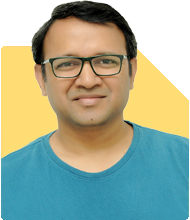Ramalingam Kalirajan |10894 Answers |Ask -Follow
Mutual Funds, Financial Planning Expert - Answered on Oct 24, 2024
He has an MBA in finance from the University of Madras and is a certified financial planner.
He is the director and chief financial planner at Holistic Investment, a Chennai-based firm that offers financial planning and wealth management advice.... more

Dear Sir/Ma'am, I am 43 years old and need some wealth planning advise. My take home salary after PF deduction is 3 lakhs per month. I have following savings: PF - 77 Lakhs ; PPF (Between me and my wife) - 20 Lakhs ; Superannuation - 25 Lakhs ; ULIP - 15 Lakhs ; MF - 20 Lakhs ; Stocks (under loss of 3 lakhs) - 6 Lakhs ; Cash - 3 Lakhs. I have a 6 year old son for whom I invest 1.5 lakhs every year under ICICI perfect scheme. Post retirement (I am planning when I am 50), I want 1 lakh Rs per month. I have no debts as of now. Have one flat already occupied worth 1.5 Cr and booked another recently 1.1 CR which will be delivered in 2029 Mid. I stay in Bangalore
Review of Current Savings and Investments
Provident Fund (PF): Rs 77 Lakhs
This is a stable, long-term investment with tax-free benefits upon withdrawal. The balance will grow further until you retire, making it a solid base for your retirement corpus.
Public Provident Fund (PPF): Rs 20 Lakhs (combined between you and your wife)
PPF offers safe returns, though the lock-in period must be considered. It matures soon, and you can either withdraw or reinvest.
Superannuation: Rs 25 Lakhs
Your superannuation fund can serve as a key retirement income generator, especially since it offers regular payouts upon maturity.
ULIP: Rs 15 Lakhs
ULIP can sometimes have high charges. You may want to review the charges and see if switching to a better investment makes sense. However, if you hold it for a longer duration, it may deliver decent returns.
Mutual Funds (MF): Rs 20 Lakhs
Mutual funds are a crucial part of your portfolio. This investment needs to be nurtured with a balanced strategy. Keep your portfolio well-diversified with large-cap and mid-cap actively managed funds to boost growth potential.
Stocks: Rs 6 Lakhs (with Rs 3 lakh loss)
The stock market can be volatile, but it can also offer higher returns in the long run. Consider whether holding onto underperforming stocks is worth it or if reallocating to more stable options would benefit your overall portfolio.
Cash: Rs 3 Lakhs
This is useful for emergencies but earns no returns. You could consider investing some of this for better returns while keeping some liquidity for short-term needs.
Real Estate (Two Flats): Occupied flat worth Rs 1.5 Cr and another booked for Rs 1.1 Cr (due for delivery in 2029)
While real estate offers stability, the second property should be carefully evaluated. It locks up a large sum until completion. Focus on liquidity and other investments to support your retirement goals.
Addressing Your Retirement Goal
You plan to retire in 7 years, at 50, and need Rs 1 lakh per month post-retirement. Let’s analyse whether your current savings and investments can support this.
PF and Superannuation:
Your PF and superannuation combined will likely grow substantially by 50. This corpus will serve as a foundation for generating a steady income post-retirement. You can withdraw or set up a Systematic Withdrawal Plan (SWP) to draw monthly income from these funds.
PPF and ULIP:
When your PPF matures, reinvesting the proceeds in a safer option could ensure steady growth without much risk. Similarly, you can evaluate if continuing ULIP is beneficial or if switching is a better option.
Mutual Funds and Stocks:
These should continue to form a core part of your portfolio. For consistent post-retirement income, you may consider shifting some of your mutual fund holdings to a balanced or conservative fund as you near retirement.
Investment Planning for Son's Education
You’ve been regularly investing Rs 1.5 lakhs per year for your son's future under the ICICI Perfect Scheme. This is a good start, but do ensure that this investment is flexible enough to adjust to changing financial needs. Review the scheme’s performance to see if it matches your long-term educational goals for your son.
Suggested Strategy for Your Portfolio
Diversify Further:
You have a strong base of investments, but further diversification into different asset classes, especially debt and hybrid mutual funds, could balance risk and return. These will give you a steady stream of income post-retirement.
Actively Managed Funds vs Index Funds:
If you have considered index funds, keep in mind that they simply track the market. Actively managed funds, especially through a qualified Certified Financial Planner, can provide better risk management. A professional manager can rebalance the portfolio to adapt to market conditions, thus optimizing returns.
Review Your Loss-Making Stocks:
Stocks with losses could be a drag on your portfolio. Evaluate whether holding them makes sense or if reallocating to more reliable sectors or large-cap stocks would be beneficial.
Tax Efficiency and Withdrawal Planning
You should also be mindful of the tax implications of your investments.
Capital Gains Tax:
Equity mutual funds incur 12.5% tax on LTCG above Rs 1.25 lakhs, and STCG is taxed at 20%. For debt mutual funds, both LTCG and STCG are taxed as per your tax slab.
Regular Withdrawal Plan:
To generate a steady Rs 1 lakh post-retirement income, consider SWPs from mutual funds. These provide a consistent cash flow while letting the rest of your portfolio continue to grow. Balance this with a mix of debt and hybrid funds to ensure a steady income stream with minimal risk.
Final Insights
You are on a sound financial path, and with careful adjustments, you can comfortably retire at 50. Focus on:
Diversifying your mutual funds
Re-evaluating ULIP charges
Minimizing underperforming stocks
Building a tax-efficient withdrawal strategy for your post-retirement income
Best Regards,
K. Ramalingam, MBA, CFP,
Chief Financial Planner,
www.holisticinvestment.in
https://www.youtube.com/@HolisticInvestment
You may like to see similar questions and answers below
Ramalingam Kalirajan |10894 Answers |Ask -Follow
Mutual Funds, Financial Planning Expert - Answered on Jul 12, 2024
Ramalingam Kalirajan |10894 Answers |Ask -Follow
Mutual Funds, Financial Planning Expert - Answered on May 30, 2025
Ramalingam Kalirajan |10894 Answers |Ask -Follow
Mutual Funds, Financial Planning Expert - Answered on Jul 22, 2025
Mayank Chandel |2576 Answers |Ask -Follow
IIT-JEE, NEET-UG, SAT, CLAT, CA, CS Exam Expert - Answered on Dec 17, 2025
Radheshyam Zanwar |6747 Answers |Ask -Follow
MHT-CET, IIT-JEE, NEET-UG Expert - Answered on Dec 16, 2025
Shalini Singh |181 Answers |Ask -Follow
Dating Coach - Answered on Dec 16, 2025
Patrick Dsouza |1429 Answers |Ask -Follow
CAT, XAT, CMAT, CET Expert - Answered on Dec 16, 2025
Nayagam P P |10858 Answers |Ask -Follow
Career Counsellor - Answered on Dec 16, 2025
Nayagam P P |10858 Answers |Ask -Follow
Career Counsellor - Answered on Dec 16, 2025
Samraat Jadhav |2510 Answers |Ask -Follow
Stock Market Expert - Answered on Dec 16, 2025
Samraat Jadhav |2510 Answers |Ask -Follow
Stock Market Expert - Answered on Dec 16, 2025
Nayagam P P |10858 Answers |Ask -Follow
Career Counsellor - Answered on Dec 16, 2025
Nayagam P P |10858 Answers |Ask -Follow
Career Counsellor - Answered on Dec 16, 2025























